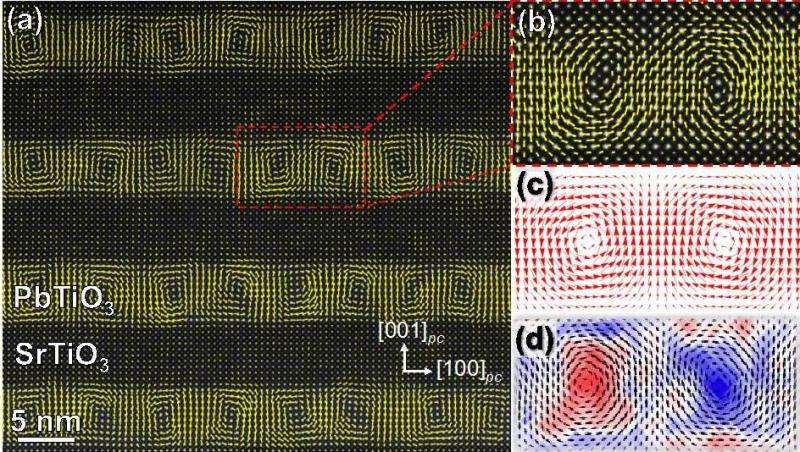
A new form of matter, in which electrical charge swirls in “polar vortices,” has been observed in a ferroelectric material.
Notably, ferroelectric materials display unique electrical or magnetic properties, as such, the discovery holds intriguing possibilities for advanced kinds of memory and processors that take up far less space, and could also “rewrite our basic understanding of ferroelectrics,” according to the researchers who observed them.
Observing Swirling Polar Vortices
A team of scientists with the U.S. Department of Energy (DOE)’s Lawrence Berkeley National Laboratory and the University of California were the ones who observed the rotating polar vortices made of lead titante and strontium titante.

The team compares the vortices to swirls of magnetism known as “skyrmions.” If, indeed, the vortices prove to be electrical skyrmions, they could find potential applications in ultracompact data storage and processing, and could also lead to the production of new states of matter.
“Ferroelectric materials such as the materials used in this work have produced a number of exciting emergent properties over the years, but these smoothly-rotating polar vortex structures really are different,” says Lane Martin, a faculty scientist with Berkeley Lab’s Materials Sciences Division and Associate Professor in UC Berkeley’s Department of Materials Science and Engineering, who is this study’s co-principal investigator.
“I think if you surveyed the community many would shake their heads in disbelief at such structures, but it turns out there really is a tendency for vortex states to form in nature even in these polar systems. And, when one looks more broadly, vortex structures can occur across huge length scales – from galaxies and weather systems all the way down to 10s of atoms as in our case.”
This is the first time these swirls of electrical activity have been observed experimentally. To see them, the team created carefully repeating layers of lead titanate and strontium titante, each one just 0.4 nanometers thick. Competing energies within the “superlattices” give rise to some strange effects, as Lane Martin, one of the researchers, explained to PhysOrg:
“As we tune the period lengths of our superlattices, we can tune the relative importance of these… energy scales. Although rather exotic things can occur if one changes the superlattice period to be both smaller and bigger than we studied here, we really found the ‘sweet-spot’ in this work that produced these polar vortices which are an entirely new phenomenon.”
A combination of scanning transmission electron microscopy and X-ray diffraction were used to observe and characterize the vortices in the material. The STEM work was carried out at Berkeley Lab’s Molecular Foundry, a DOE Office of Science User Facility, on TEAM 0.5, the world’s most powerful transmission electron microscope. The X-ray diffraction work was carried out at the Advanced Photon Source, another DOE Office of Science User Facility, which is hosted by DOE’s Argonne National Laboratory.
Just the Beginning

Magnetic vortices can be influenced by magnetic fields. Likewise, external electrical impulses could affect these electrical vortices. This could potentially make them a means of storing data at the nanoscale. In theory, each vortex could be coded to hold information.
This isn’t happening tomorrow. But researchers do believe this discovery will have an impact on how we store data and observe matter in the future.
“This is just the beginning for the study of polar vortices in ferroelectric materials,” Martin says. “We’re observing a new state of matter and we have our work cut out for us in mapping and understanding how it evolves. We can imagine adding a magnetic spin component to similar superlattices and thus potentially paving a pathway to fundamentally demonstrate electric-field control of magnetism.”